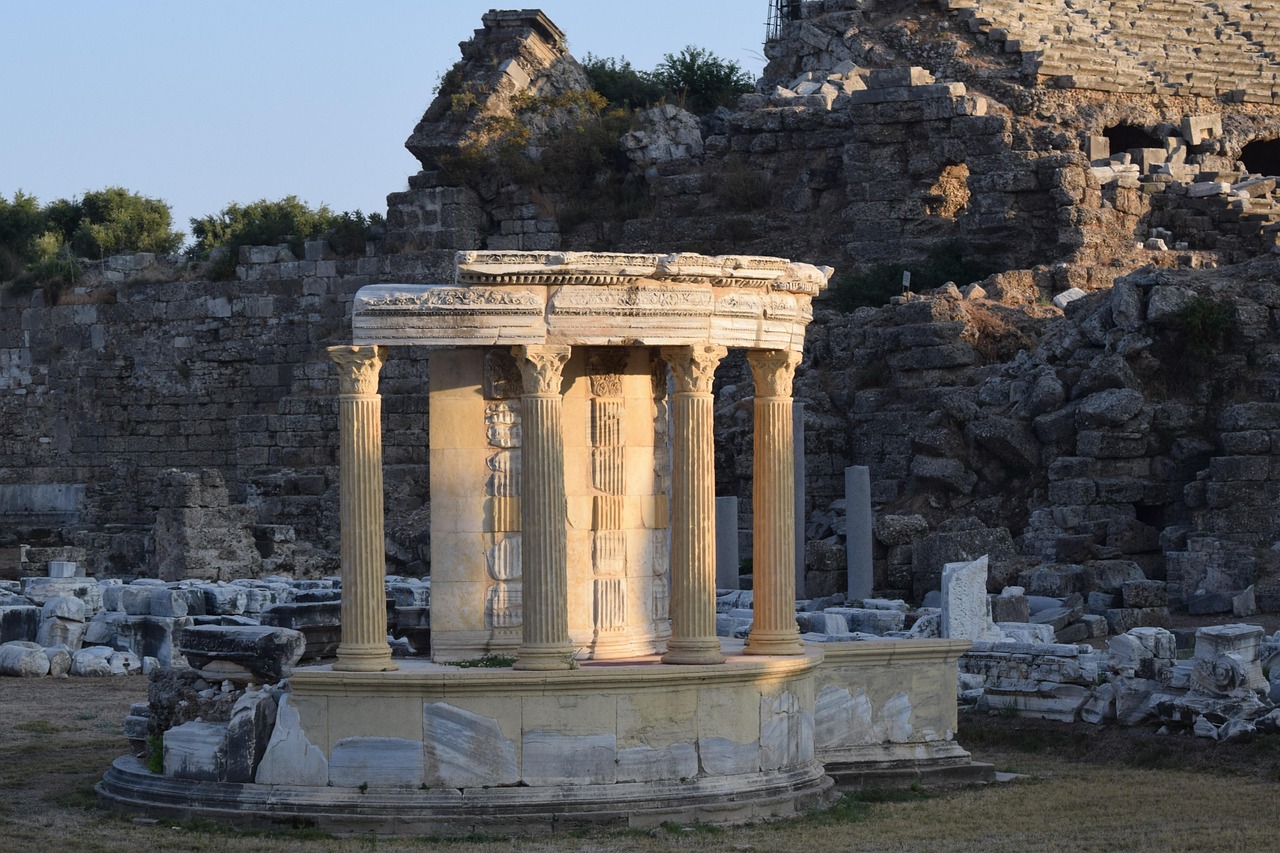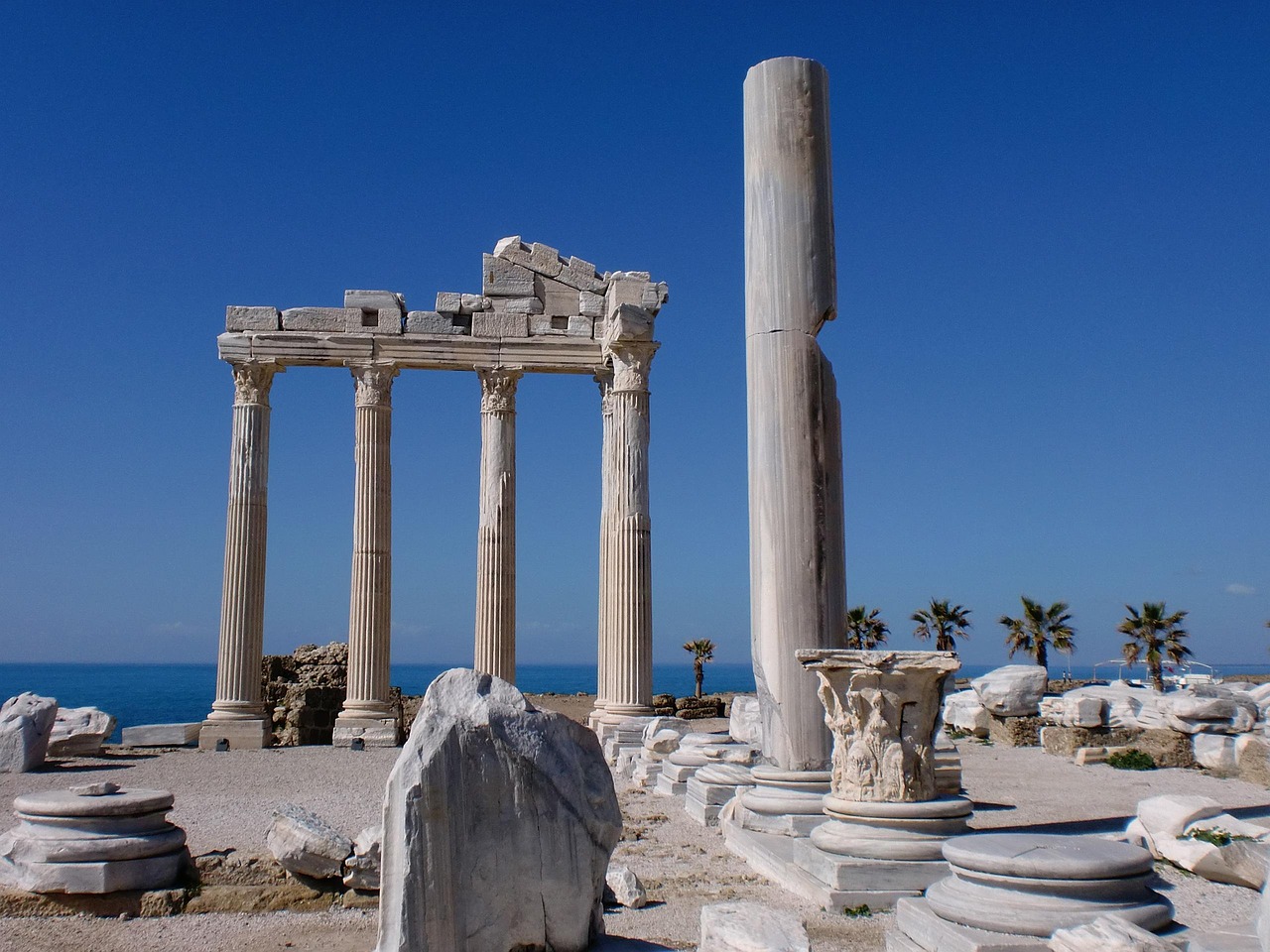Commercial Agora of Side
Roman Site in Side

The Side Commercial Agora is one of the most captivating archaeological sites in the ancient city, offering a vivid picture of daily life in Roman times. Located near the Roman Theatre, this large square once served as the bustling hub of trade, filled with merchants selling goods brought by sea from across the Mediterranean. Its colonnaded walkways, temple ruins, and rows of ancient shops make it one of the top attractions in Side and a highlight of any walking tour of Side.
Wandering through the Agora today, you can still sense the energy that once filled the space. The worn paving stones and crumbling storefronts tell stories of a city that prospered through commerce and connection. This spot is one of the best places to see in Side for travelers who enjoy blending archaeology with imagination, allowing history to come alive amid the sunlit ruins.
History and Significance
Built during the 2nd century CE, the Commercial Agora was the economic center of Roman Side, where merchants traded olive oil, spices, textiles, and precious metals. The square measured about 90 meters on each side and was surrounded by colonnades that housed dozens of shops. In the middle stood a small circular temple dedicated to Tyche, the goddess of fortune — a fitting tribute for a marketplace that drove the city's prosperity.
The site also played a civic role, with parts of it used for public announcements and local administration. Archaeologists have discovered fragments of statues, altars, and inscriptions here, revealing the Agora's dual function as both a place of trade and community gathering. During the Byzantine era, it continued to serve as a commercial center before being gradually abandoned as the city declined.
Things to See and Do
Visitors can walk around the square's perimeter to view the remains of its colonnaded shops and admire the central temple ruins. Many of the marble column bases still stand, giving a sense of the structure's scale and symmetry. Look for the remnants of shop counters and carved stones that once decorated merchant stalls. The area around the Agora also features parts of the ancient drainage system, showcasing Roman engineering at its finest.
The proximity of the Agora to the Roman Theatre makes it a great place to visit on a walking tour of Side, as the two sites were historically linked — theatre-goers would often pass through the marketplace after performances. It's also a peaceful spot to take a break and imagine the lively sounds of trade that once echoed between the columns.
Practical Tips
- Best time to visit: Morning or late afternoon for cooler weather and good light for photos
- Entrance fee in Euros: Free (included within the archaeological zone)
- Opening hours: Always open
- How long to spend: 30–45 minutes
- Accessibility: Mostly flat terrain with some uneven stones
- Facilities: Restrooms and cafes nearby in the old town
- Photography tip: Capture the ruins from the southwest corner to include the theatre in the background
- Guided tours: Frequently included in Side's historical tours
- Nearby food options: Small restaurants and snack bars within walking distance
How to Get There
The Commercial Agora is located directly next to the Roman Theatre in the heart of ancient Side, about a 10-minute walk from the main city gate. If you're arriving from Antalya (around 65 kilometers away), you can take a bus to Manavgat and then a dolmuş (shared minibus) or taxi into Side. Once inside the archaeological area, signs clearly point toward the theatre and Agora.
Is the Side Commercial Agora Worth Visiting?
Definitely. The Commercial Agora is one of the must-see places in Side, offering a tangible link to the city's prosperous past. Its well-preserved layout and setting near other major landmarks make it both educational and visually captivating. For travelers interested in ancient commerce, daily life, and Roman architecture, it's a fascinating stop that adds depth to any exploration of Side's ruins.
Other Sites Nearby
- Side Museum – Situated in a Roman bathhouse, displaying statues, mosaics, and artifacts unearthed from the surrounding ruins.
- Roman Theatre – A magnificent amphitheater that once hosted gladiator games and cultural events, located right next to the Agora.
- Temple of Apollo – Stunning seaside ruins known for their sunset views and elegant marble columns.
- Nymphaeum – The monumental Roman fountain that greeted travelers entering ancient Side.
- Vespasian Monumental Gate – A triumphal arch marking the ceremonial entrance to the city.
The Commercial Agora of Side appears in our Complete Guide to Visiting Side!
This website uses affiliate links which may earn a commission at no additional cost to you!
Visiting Commercial Agora of Side
Nearby Attractions
- Vespasian Monumental Gate (0.1) km
Historic Site in Side - Roman Theatre (0.1) km
Historic Site in Side - Museum of Side (0.1) km
Museum in Side - Side Byzantine Hospital (0.2) km
Historic Site in Side - State Agora of Side (0.2) km
Roman Site in Side - Colonnaded Street of Side (0.3) km
Historic Site in Side - Ancient City Walls of Side (0.4) km
Historic Site in Side - Side Nymphaeum (0.5) km
Historic Site in Side - Temple of Apollo (0.6) km
Historic Site in Side - Side Harbour (0.7) km
Harbour in Side


